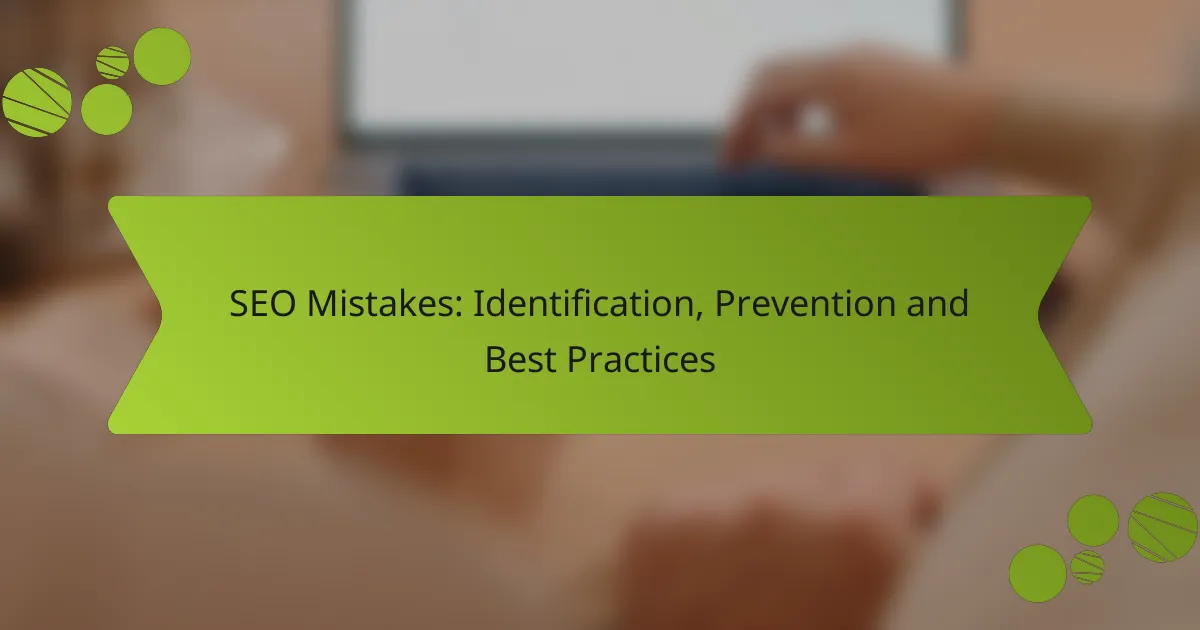Understanding and addressing common SEO mistakes is essential for improving your website’s visibility and performance in search engine results. By systematically identifying these errors and implementing best practices, you can enhance your site’s structure, content quality, and backlink profile, ultimately driving more organic traffic to your site.

What are the common SEO mistakes to avoid?
Common SEO mistakes can significantly hinder your website’s visibility and performance in search engine results. Identifying and preventing these errors is crucial for effective online marketing and achieving higher rankings.
Ignoring keyword research
Ignoring keyword research can lead to targeting the wrong audience and missing out on valuable traffic. Conduct thorough keyword analysis to understand what terms potential customers are using to find products or services similar to yours.
Utilize tools like Google Keyword Planner or SEMrush to identify relevant keywords with good search volume and manageable competition. Aim for a mix of short-tail and long-tail keywords to capture a broader audience.
Neglecting mobile optimization
Neglecting mobile optimization can result in a poor user experience for mobile visitors, which can negatively impact your search rankings. With a significant portion of web traffic coming from mobile devices, ensuring your site is responsive is essential.
Test your website’s mobile-friendliness using Google’s Mobile-Friendly Test tool. Focus on fast loading times, easy navigation, and readable text without the need for zooming. A well-optimized mobile site can enhance user engagement and improve SEO performance.
Overlooking meta tags
Overlooking meta tags, such as title tags and meta descriptions, can limit your site’s click-through rate from search results. These tags provide search engines with essential information about your content and influence how users perceive your site.
Craft unique and compelling meta tags for each page, incorporating primary keywords naturally. Keep title tags under 60 characters and meta descriptions under 160 characters to ensure they display correctly in search results.
Failing to optimize for local search
Failing to optimize for local search can prevent your business from reaching nearby customers. Local SEO is vital for businesses that rely on local clientele, as it helps you appear in relevant local searches.
Claim your Google My Business listing and ensure your name, address, and phone number (NAP) are consistent across all platforms. Incorporate local keywords and encourage customer reviews to enhance your local search visibility.
Using duplicate content
Using duplicate content can confuse search engines and dilute your site’s authority, leading to lower rankings. Search engines prefer unique content that provides value to users, so it’s essential to avoid duplication.
Utilize tools like Copyscape to check for duplicate content on your site and across the web. If you must use similar content, consider using canonical tags to indicate the preferred version to search engines, ensuring your original content is prioritized.

How can I identify SEO mistakes?
Identifying SEO mistakes involves a systematic approach to uncover issues that may hinder your website’s performance. By leveraging various tools and techniques, you can pinpoint areas for improvement and enhance your search engine visibility.
Utilizing SEO audit tools
SEO audit tools are essential for identifying technical issues, on-page optimization problems, and overall site health. Popular tools like SEMrush, Ahrefs, and Moz can provide comprehensive reports on factors such as broken links, missing meta tags, and page speed.
When using these tools, focus on key metrics such as crawl errors, mobile usability, and keyword rankings. Regular audits, ideally every few months, can help you stay on top of potential issues and adapt to changing search engine algorithms.
Analyzing website analytics
Website analytics platforms, such as Google Analytics, are crucial for understanding user behavior and traffic patterns. By examining metrics like bounce rate, average session duration, and traffic sources, you can identify pages that may need optimization.
Look for significant drops in traffic or high bounce rates on specific pages, as these can indicate SEO mistakes. Set up goals and conversion tracking to measure the effectiveness of your SEO efforts and make data-driven decisions.
Conducting competitor analysis
Competitor analysis helps you understand what strategies are working for others in your niche. By examining competitors’ keyword rankings, backlink profiles, and content strategies, you can uncover gaps in your own SEO approach.
Tools like SpyFu and SimilarWeb can provide insights into your competitors’ performance. Regularly compare your metrics against theirs to identify areas where you can improve and stay competitive in search results.

What are best practices for SEO?
Best practices for SEO involve strategies that enhance a website’s visibility in search engine results. These practices focus on improving site structure, content quality, and backlink profiles to attract organic traffic effectively.
Implementing structured data
Structured data helps search engines understand the content of your site better, improving how your pages are displayed in search results. By using schema markup, you can provide additional context about your content, such as product details, reviews, or events.
To implement structured data, identify the relevant schema types for your content and add the appropriate markup to your HTML. Tools like Google’s Structured Data Markup Helper can assist in this process. Regularly test your structured data using Google’s Rich Results Test to ensure it is correctly implemented.
Creating high-quality content
High-quality content is essential for effective SEO, as it engages users and encourages them to share your material. Focus on creating informative, relevant, and original content that addresses the needs and questions of your target audience.
Consider using a mix of formats, such as articles, videos, and infographics, to cater to different preferences. Aim for content that is at least 1,000 words long, as longer articles often perform better in search rankings. Regularly update your content to keep it fresh and relevant.
Building authoritative backlinks
Building authoritative backlinks is crucial for improving your site’s credibility and search engine ranking. Backlinks from reputable sites signal to search engines that your content is trustworthy and valuable.
To acquire quality backlinks, focus on creating shareable content and engaging with industry influencers. Guest blogging on relevant sites and participating in online forums can also help you gain exposure. Avoid low-quality link-building tactics, as they can harm your site’s reputation and ranking.

How can I prevent SEO mistakes?
Preventing SEO mistakes involves a proactive approach that includes regular content updates, staying informed about the latest trends, and conducting periodic audits. By implementing these strategies, you can enhance your website’s performance and visibility in search engine results.
Regularly updating content
Regularly updating content is crucial for maintaining relevance and authority in your niche. Search engines favor fresh content, so aim to review and refresh your articles, blog posts, and product descriptions at least every few months. This can include adding new information, optimizing for current keywords, or improving readability.
Consider creating a content calendar to schedule updates. This helps ensure that no piece of content becomes outdated. Additionally, monitor user engagement metrics to identify which pages may need revisions based on performance.
Staying informed on SEO trends
Staying informed on SEO trends is essential for adapting your strategies to changing algorithms and user behavior. Follow reputable SEO blogs, attend webinars, and participate in industry forums to keep up with the latest best practices. This knowledge can help you avoid common pitfalls and capitalize on new opportunities.
Subscribe to newsletters from SEO experts or organizations, which often provide insights and updates directly to your inbox. Engaging with the SEO community on social media platforms can also provide real-time information and discussions about emerging trends.
Conducting periodic audits
Conducting periodic audits of your website is vital for identifying and rectifying SEO mistakes. Regular audits can help you assess technical aspects like site speed, mobile-friendliness, and broken links, as well as on-page elements such as meta tags and keyword usage. Aim to perform a comprehensive audit at least twice a year.
Utilize tools like Google Search Console, SEMrush, or Ahrefs to facilitate your audits. These tools can provide valuable insights into your site’s performance and highlight areas for improvement. Create a checklist of key elements to review during each audit to ensure nothing is overlooked.

What tools can help with SEO optimization?
Several tools can significantly enhance SEO optimization by providing insights into website performance, keyword rankings, and competitor analysis. Utilizing these tools effectively can streamline your SEO efforts and improve your site’s visibility in search engines.
Google Search Console
Google Search Console is a free tool that helps website owners monitor and maintain their site’s presence in Google search results. It provides valuable data on search traffic, indexing status, and potential issues affecting your site’s performance.
Key features include performance reports, which show how your site ranks for various keywords, and the ability to submit sitemaps for better indexing. Regularly checking for crawl errors and mobile usability issues can help maintain optimal site health.
SEMrush
SEMrush is a comprehensive SEO tool that offers keyword research, site audit, and competitive analysis features. It allows users to track their rankings and identify opportunities for improvement by analyzing competitors’ strategies.
With SEMrush, you can access a vast database of keywords and their search volumes, helping you to target the right terms. The site audit feature highlights technical issues that may hinder your SEO efforts, such as broken links or slow loading times.
Ahrefs
Ahrefs is another powerful SEO tool known for its backlink analysis capabilities. It provides insights into your website’s link profile and helps identify high-quality backlink opportunities to enhance your site’s authority.
In addition to backlink analysis, Ahrefs offers keyword research tools and content gap analysis, allowing you to discover topics your competitors rank for that you may have overlooked. Regularly using Ahrefs can help refine your content strategy and improve your search rankings.









